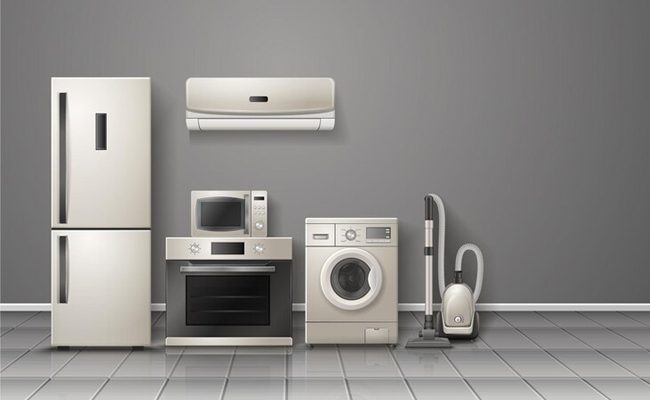
As homeowners, we often take our appliances for granted, only noticing their importance when they break down. Regular maintenance can not only prevent costly repairs but also extend the life of your appliances. Here’s a yearly guide to keeping everything from your refrigerator to your washing machine in top shape.
Refrigerator & Freezer
1. Clean the Condenser Coils: At least once a year, pull your refrigerator away from the wall and clean the condenser coils with a coil brush or vacuum. Dust and pet hair can accumulate on these coils, forcing your refrigerator to work harder and consume more energy.
2. Check Door Seals: A loose seal allows cool air to seep out, wasting energy and causing your fridge to work harder. Make sure the seals are free of food residue by cleaning them with a mild detergent and water. Check for wear and replace if needed.
3. Defrost: If your freezer isn’t frost-free, be sure to defrost it once the ice has built up to about a quarter-inch thick. This helps improve efficiency and create more space for storage.
Oven & Range
1. Clean Regularly: Keep your oven and stovetop clean from grease buildup and food spills to prevent fires and ensure even cooking. Use the self-cleaning function if available, but make sure to wipe down manually any leftover residues.
2. Inspect Your Gas Stove Igniter: For gas stoves, if the igniter is slow or fails to light, it might be clogged. Clean it gently with a toothbrush and check the burner holes for obstructions.
3. Replace Filters: If you have a range hood, replace or clean the filters annually. This helps in maintaining good air quality and keeps the hood working efficiently.
Dishwasher
1. Clean the Filter: Many people don’t realize their dishwasher has a filter that needs regular cleaning. Remove it and rinse under running water to remove any food particles and grease.
2. Check and Clean Spray Arms: Ensure the holes on the spray arms aren’t clogged with debris. Clean them with a toothpick or small brush to ensure water can flow freely.
3. Inspect the Door Seal: Just like your refrigerator, the dishwasher door seal can become dirty or damaged. Clean it with soap and water and check for any signs of wear.
Washing Machine
1. Clean the Drum: Use a washer cleaner or a mixture of hot water and vinegar to clean the drum and remove any detergent buildup or mold. Run an empty hot cycle with this solution.
2. Inspect Hoses: Check for bulges, leaks, or cracks in the water hoses. It’s recommended to replace the hoses every five years as a preventative measure against leaks and water damage.
3. Keep it Level: Ensure your washing machine is level to prevent it from vibrating excessively, which can lead to damage over time. Adjust the legs as necessary.
Dryer
1. Clean the Lint Filter: After every load, remove and clean the lint filter. This not only prevents fire hazards but also improves efficiency.
2. Inspect Ventilation: Annually, check and clean the dryer vent and exhaust duct. Clogged vents can lead to fires and reduce the efficiency of your dryer.
3. Check the Drum Seals: If your dryer seems to take longer to dry clothes, check the drum seals. If they’re worn out, they can let hot air escape, reducing efficiency.
Air Conditioner
1. Replace or Clean Air Filters: Dirty filters restrict airflow and reduce efficiency. Check the filters every month during high usage periods and replace or clean as needed.
2. Clean Coils and Fins: Annually, clean the air conditioner’s evaporator and condenser coils. Also, straighten any bent fins with a fin comb to ensure proper airflow.
3. Check Coolant Lines: The refrigerant tubes or pipes that run from the evaporator on the air handler to the condenser outside should be insulated. Check for any damage to the insulation and replace it if necessary.
Water Heater
1. Flush the Tank: Sediment buildup can reduce your water heater’s efficiency and clog your water lines. Flush the tank annually to remove sediment by draining it fully.
2. Test the Pressure Relief Valve: This safety feature keeps pressure from building up too much in the boiler. Lift the valve’s lever and let it snap back. You should see a burst of water into the drainpipe if it’s working correctly. If not, a new valve is needed.
3. Inspect the Anode Rod: The anode rod protects your tank from rust. Checking it once a year and replacing it if more than 6 inches of the core steel wire is exposed can prevent rust and extend the life of your water heater.
Final Thoughts
Regular maintenance of your home appliances can save you from the inconvenience of breakdowns and the cost of replacements. By following these yearly tips, you can ensure that your appliances run smoothly and efficiently, prolonging their lifespan and saving you money in the long run. Remember, taking a little time for appliance maintenance can lead to a lot of time saved from dealing with repairs and replacements.
Leave a Reply